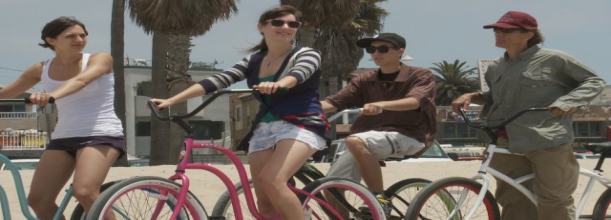Interview! We talk to the star and director of Donor Unknown

JoEllen Marsh helped set in motion a story which brought her together with her unknown half-brothers and sisters across America and her long awaited meeting with Jeffrey, her sperm donor father who lives in an RV on Venice beach with his dogs and an injured pigeon. JoEllen and director Jerry Rothwell give us some insight into what they wanted to get out of making Donor Unknown and what it’s like uniting a father and daughter for the first time in front of a camera.
When did the idea of making the documentary come about?
Jerry: I think the first idea for the film was in about 2007 which was probably a couple of years before the New York Times article [JoEllen’s first meeting with her sister Danielle resulted in a front page New York Times article that kick started everything]. You [JoEllen] had met Danielle [her half-sister] and Ryan [half-brother] and Danielle had met Jeffrey. But JoEllen had made the decision not to meet Jeffrey initially I guess.
JoEllen: I think it was just more circumstantial. It just wasn’t time yet. I had been open to doing a film for a while and then the opportunity came up and I said go for it.
Were there any other reasons you thought this was the time to do it?
JoEllen: Well I had been waiting until I was 18 to go and meet Jeffrey and then, since I’ve been 18 I’ve been in college and had been really busy and hadn’t had the money to go out. The documentary came up and it just happened to be right around the time I was thinking of going out anyway.
Jerry: That was great for us because JoEllen was the first person to really go looking for Jeffrey so, in a way, she was going to tell the story that had already happened and we were able to follow her through the next stage of the process. So in terms of structuring a film which could have included lots of different characters, it was great.
So it was a happy coincidence rather than a conscious decision to focus it on JoEllen’s story?
Jerry: When we started the film we didn’t really know that anyone wanted to meet him within the time frame that we had to make the film. The way these films work it often takes a couple years to fundraise for them. The upside of that is that you can see time unfold in the film. So, no, I don’t think initially we thought that would be the way to do it but as soon as we met JoEllen and she was interested in going and willing for us to film that process we did it about 6 months later.
Did you want to bring more attention to the Donor Sibling Registry? Was there an agenda, for you, JoEllen, to get this story heard so more people might follow your footsteps?
I think that’s what happened. Part of the reason I did it was so that more people would be aware of the sort of families the donor conception is creating. I really hope that more people will be willing to go on the registry and sign up, especially sperm donors, possibly.
JoEllen, how many siblings have you encountered through making the film? Are you finding more and more?
Well I met one through the film so by the end of the film I had met seven of my sibings. If more come up I would be happy to meet them, I would love to meet them. But it’s not really so much looking for them; we are all on the registry and the story is pretty much out there so if they come looking for us, that’s great. There’s really no way of knowing how many there are. We know of 14, total, that exist, including me.
So there was no way of taking the film to its logical conclusion, and trying to find more and more siblings?
Jerry: It was really dependant on people wanting to look and going on the donor registry. In order to do that they both have to know that they were donor conceived and have the information to look. So we were quite dependant on people coming forward. For me, what was interesting about the story was that there was this very personal arena in which some quite big issues about modern technology and the technology of reproduction were playing out. I think JoEllen and Jeffrey and Danielle are kind of pioneers of this new kind of family, in a way. I don’t know if that’s fair to say. It’s quite a new phenomenon that’s made possible through internet.

Obviously Jeffrey himself plays a big role in the film. He’s an interesting guy, to say the least. Do you think his personality helps make the film was it is?
Jerry:I think if Jeffrey had been a medical student who had donated and was a doctor with a family it would have been a very different story. I think because Jeffrey is who he is for me it becomes a much richer story, also about expectations and what those mean. Jeffrey is someone that isn’t in a nuclear family but then a family’s coming to meet him and I’m kind of interested in someone who doesn’t have lots of close family relationships around him, where he lives, but has this extended family across the states. So it made it a very different kind of film, I think.
JoEllen, how did you find meeting Jeffrey on film? Did you wish you could have done it without the camera, on your own terms?
JoEllen:Well I think now I’m really happy that the camera was there just because I have a record of it. I can always go back and watch the film and show my kids, you know, this is the way it happened, this is how I met my sperm donor. But at the time I had been used to the camera being around me and we’d filmed at my home town for about five days before that so I was kind of used to it. And he [Jerry] really did try to back off when I was first meeting him. It would have been an awkward meeting anyway, I don’t think the cameras really changed it that much.
Do you think Jeffrey would have been any different, had the cameras not been there?
Jeffrey’s always going to be a character. I did get time with Jeffrey later, so that was all I wanted.

Like you say the final meeting is quite awkward, not overly emotional. What kind of directorial stance can you take on something like that?
Jerry: We didn’t go down the route of trying to edit out the awkwardness because I think awkwardness is part of that kind of meeting. It’s definitely a consideration about how do you enable this meeting, which is much more important than the film, to happen, but also get enough of it to put into the film. But radio mics are a wonderful thing. I think there was a point where I was walking across the car park from JoEllen and I was able to stop maybe 100 yards away from where she greeted Jeffrey and the two of them were on radio mics. There was a then a little get together where we were really quite far back but there was enough audio and visually you see it happening. I quite like the way the audience are slightly held away from it at that point, because it is a kind of private moment. It’s one of the strange things about new camera technology, people say it’s very unobtrusive but it’s kind of the opposite in a way. Because it is so unobtrusive it’s quite intrusive in the way it can penetrate people’s private moments and make them public.
JoEllen, what have you been up to since the filming and how are your relationships with everyone now?
Since then I’ve been studying aboard in Jordan so I’ve been disengaged from a lot of things but I keep in contact with Jeffrey, we email back and forth every couple weeks. He sends me pictures of random animals that he’s rescued. I’ve also got to hang out with my half-sister Danielle at the Tribeca Film Festival and meet Jeffrey’s brother. So that was a cool experience.
Where’s Jeffrey now? Still on Venice beach?
Jerry: Just after he finished the film he moved out of Venice and kind of had a cabin in the woods for a while. In the process he’s lost his RV and is back in Venice. Without the pigeon though because the pigeon died. It was killed by crows! It was very sad.
JoEllen and Jerry, thank you very much.
Donor Unknown was released nationwide on 3rd June.






Recent Comments